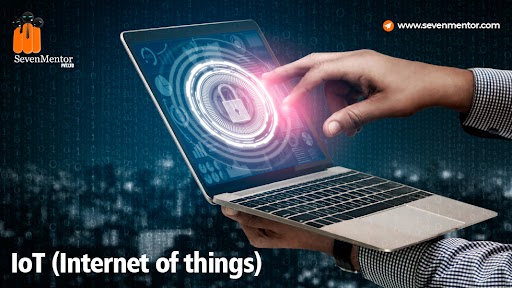IoT (Internet of Things)
The IoT (Internet of Things) has emerged as a transformative technology, revolutionizing the way we interact with our surroundings and enabling a new level of connectivity between devices, objects, and people. In this article, we will explore what IoT is, how it works, its applications, and the potential benefits and challenges associated with this rapidly growing field.
What is IoT (Internet of Things)?
The Internet of Things refers to the network of physical devices, vehicles, appliances, and other objects embedded with sensors, software, and connectivity capabilities that enable them to collect and exchange data over the Internet. These interconnected devices can communicate with each other and with humans, allowing for seamless integration and automation of various processes.
For Free Demo classes Call: 7507414653
Registration Link: Click Here!
HOW DOES IoT (Internet of Things) WORK?
IoT devices are equipped with sensors or actuators that gather data from their environment or perform specific actions. These devices are connected to a network infrastructure, which facilitates the exchange of data between the devices and central servers or cloud platforms. The collected data is analyzed, processed, and shared with relevant stakeholders, enabling informed decision-making and automated actions.

-
Applications of IoT (Internet of Things):
The applications of IoT span various industries and sectors, including:
-
Smart Homes:
IoT devices enable homeowners to control and automate lighting, security systems, temperature, and home appliances remotely. They can also monitor energy usage and optimize resource consumption.
-
Industrial Automation:
IoT is revolutionizing manufacturing processes by connecting machines, sensors, and systems, leading to enhanced productivity, predictive maintenance, and real-time monitoring of equipment.
-
Healthcare:
IoT plays a vital role in remote patient monitoring, wearable devices, and real-time health tracking. It enables healthcare professionals to deliver personalized care, monitor vital signs, and respond promptly to emergencies.
-
Smart Cities:
IoT infrastructure is used to monitor and manage traffic flow, optimize energy consumption, improve waste management, enhance public safety, and enable efficient urban planning.
Note: Master the future of technology with our IoT classes in Pune. Learn to design, develop, and implement IoT solutions for a connected world. Join us and become an IoT expert!
For Free Demo classes Call: 7507414653
Registration Link: Click Here!
BENEFITS OF IOT:
IoT offers numerous advantages, including:
- Efficiency and Automation: IoT streamlines operations, reduces manual intervention, and automates routine tasks, leading to increased efficiency and productivity.
- Enhanced Decision-making: Real-time data collected by IoT devices provides valuable insights, enabling businesses and individuals to make informed decisions promptly.
- Improved Quality of Life: IoT applications in healthcare, smart homes, and wearable technology contribute to better health monitoring, convenience, and overall well-being.
-
Challenges and Considerations:
While IoT brings immense potential, it also presents challenges such as:
Security and Privacy:
With a vast number of interconnected devices, ensuring data security and protecting privacy becomes crucial. Measures must be implemented to prevent unauthorized access and data breaches.
Interoperability:
As IoT ecosystems involve devices from different manufacturers and platforms, ensuring seamless communication and interoperability between devices can be a challenge.
Scalability:
The sheer scale of IoT deployments requires robust network infrastructure, data storage, and processing capabilities to handle the massive volume of data generated.
For Free Demo classes Call: 7507414653
Registration Link: Click Here!
TYPES OF ATTACK ON IOT DEVICES
IoT devices, being interconnected and often deployed in critical systems, are susceptible to various types of attacks. Here are some common types of attacks on IoT devices:
-
Malware and Botnets:
Malicious software, such as malware, can infect IoT devices, compromising their security and functionality. Once infected, these devices can be controlled by attackers and become part of a botnet—an army of compromised devices. Botnets can be used for distributed denial-of-service (DDoS) attacks, where a large number of devices overwhelm a target system or network with an influx of traffic, causing it to become inaccessible.
-
Physical Attacks:
Physical attacks involve unauthorized access to IoT devices. Attackers may physically tamper with devices, such as manipulating sensors or replacing firmware, to gain control or extract sensitive information. Physical attacks are particularly concerning for IoT devices deployed in critical infrastructure or industries like healthcare and transportation.
-
Eavesdropping and Data Interception:
IoT devices often transmit data over networks, making them susceptible to eavesdropping attacks. Attackers intercept and capture the transmitted data, which can include sensitive information like personal details, passwords, or confidential business data. Eavesdropping attacks can occur through network sniffing, compromised routers, or insecure communication protocols.
-
Denial-of-Service (DoS) Attacks:
DoS attacks aim to disrupt the availability of an IoT device or network. Attackers overwhelm the device or network with a flood of requests, causing it to become overloaded and unresponsive. As a result, legitimate users are unable to access the device or services. DoS attacks can target specific IoT devices or the infrastructure supporting them.
-
Man-in-the-Middle (MitM) Attacks:
MitM attacks involve intercepting and manipulating communications between IoT devices and their intended recipients. Attackers position themselves between the sender and receiver, capturing or modifying data exchanged between them without their knowledge. This allows attackers to eavesdrop, modify, or inject malicious content into the communication, potentially compromising security or hijacking control of the device.
-
Firmware Exploitation:
IoT devices rely on firmware—a combination of software and hardware—to function. Exploiting vulnerabilities in the firmware can allow attackers to gain unauthorized access, control, or manipulate the device. If devices do not receive regular firmware updates or have weak security measures, they can become easy targets for exploitation.
-
Credential Attacks:
Credential attacks involve unauthorized access to IoT devices by exploiting weak or default credentials. Many IoT devices are shipped with generic usernames and passwords, and users often neglect to change them. Attackers use brute-force attacks or guess default credentials to gain access to the device, allowing them to control or manipulate it for malicious purposes.
Note: Supercharge your career with SevenMentor’s comprehensive IoT training in Pune. Gain hands-on experience in building and deploying IoT solutions.
-
MITIGATING IOT DEVICE ATTACKS:
To mitigate attacks on IoT devices, consider the following measures:
- Strong Authentication: Implement robust authentication mechanisms, such as two-factor authentication, to prevent unauthorized access to devices.
- Encryption: Ensure end-to-end encryption of data transmitted between devices and networks to protect against eavesdropping and tampering.
- Regular Updates: Keep IoT device firmware and software up to date to address vulnerabilities and patch security flaws.
- Network Segmentation: Separate IoT devices from critical systems through network segmentation to contain potential breaches and limit the impact of attacks.
- Access Control: Enforce strong access control policies to limit device access and permissions only to authorized users or systems.
- Security Monitoring: Implement intrusion detection systems (IDS) and security monitoring solutions to detect and respond to suspicious activities or anomalies.
- Vendor Security Practices: When selecting IoT devices, consider the security practices of the manufacturers, including their track record of addressing vulnerabilities and providing timely updates.
Do visit our video to get more ideas: Click Here
Conclusion:
The Internet of Things represents a groundbreaking technological paradigm that is reshaping our world. By connecting devices, objects, and people, IoT is enabling unprecedented levels of automation, efficiency, and convenience. However, addressing security concerns and ensuring interoperability are essential for realizing the full potential of IoT and ensuring a safe and connected future.
Author:-
Rajat Sharma
Call the Trainer and Book your free demo Class For IoT Call now!!!
| SevenMentor Pvt Ltd.
© Copyright 2021 | SevenMentor Pvt Ltd.

